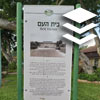On the sign:
סמל רמות השבים
ה’ליפט’
The ’Lift’
ה’ליפט’ היה אחד הסמלים של משפחות העולים מגרמניה בעלייה החמישית, בעיקר אותן משפחות שהתאפשר להן לארוז את ביתן ולהביא את תכולתו לארץ ישראל.
ה’ליפט’ הוא מכולה בעלת שילדה חזקה, המיועד להעברת סחורה כבדה על גבי משאיות, רכבות או אניות משא. הוא עשוי קורות עץ, המחוזקות בטבעות מתכת היקפיות הכוללות גם את הרצפה. בחלקו העליון לולאות ברזל המחוברות אליו מבחוץ ומאפשרות להרימו באמצעות מנוף לצורך העברתו. הקירות הפנימיים צופו בקרטון ללא זפת והעץ נמרח בחומר המגן מפני רטיבות. קירותיו החיצוניים צופו בנייר זפת.
ב’ליפט’ נארזה תכולת הבית של המשפחה - רהיטים, כלי בית, מצעדים ובגדים, תמונות,ספרים ולעיתים גם פסנתר. ה’ליפט’ על תכולתו, הועבר באחריות חברות המשלוח מבית העולה בגרמניה עד למקום התיישבותו בפלשתינה, באמצעי תחבורה שונים.
לאחר שהתחכולה המקורית הוצאה ממנו, שימש ה’ליפט’ למטרות שונות: מחסן, מקום מגורים זמני, אורווה, או מקום לעסק.
ה’ליפט’ המשופץ שלפנינו, הגיע לארץ ישראל עם משפחת ארנסט ואמי קאופמן בשנת 1938. לימים שימש ה’ליפט’ את אמי קאופמן כמספרה (אז גם נפתחו החלונות בקירותיו) ואחר כך הפך למחסן.
תודתנו למשפחת קאופמן שתרמה את ה’ליפט’ לכפר.
ה’ליפט’ שופץ בידי המועצה לשימור אתרי מורשת בישראל.
The ’lift’ was one of the symbolic characters of the German immigrant families who came to Israel on the fifth aliyah. Especially those families who were able to pack up their household goods and bring them to Palestine.
The ’lift’ is a container of an extremely strong structure. Its purpose is to transport heavy loads on trucks, trains or shipping vessels. It is made of wood planks, fastened together by peripheral metal rings including the floor. Its upper external part contains iron rings for the sole purpose of lifting it up with a crane (hence its name). The inner walls were covered by cardboard without tar, and the wood was spread with special material to protect it from humidity and moisture. The external walls were covered with tar paper.
The ’lift’ was packed up and contained the families household, such as furniture, dishes, linen, clothing, Pictures, books and occasionally a piano.
The ’lift’ with its entire content were transported from the immigrant’s house in Germany to his new dwelling in palestine, throughout assorted transport methods.
Once the original content was removed, the ’lifts’ were used for innumerable purposes: storage room, temporary living space, stable, or a business place.
This renovated lift’ arrived in Palestine with the family of Ernst and Amy Kaufmann in 1938. Later on the ’lift’ was used by Amy as a beauty parlor (this is when the windows were opened in its walls) and later on became a storage room.
Our thanks to the Kaufman family who donated the ’lift’ to our village.
The ’lift’ was renovated by the council for conservation of heritage sites in Israel. Beit ha-Am St 34 Ramot HaShavim Israel.

 Click for a larger image
Click for a larger image  Click for a larger image
Click for a larger image  Click for a larger image
Click for a larger image  Click for all signs belonging to Buildings in the history of Ramot HaShavim
Click for all signs belonging to Buildings in the history of Ramot HaShavim
 56 Meter |
56 Meter |  175 Meter |
175 Meter |  199 Meter |
199 Meter |  286 Meter
286 Meter